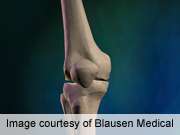Lower tourniquet cuff pressure, achieved using a limb-occlusion pressure method, is associated with reduced postoperative wound complications after total knee arthroplasty, according to research published in the Dec. 19 issue of The Journal of Bone & Joint Surgery.
(HealthDay)—Lower tourniquet cuff pressure, achieved using a limb-occlusion pressure method, is associated with reduced postoperative wound complications after total knee arthroplasty, according to research published in the Dec. 19 issue of The Journal of Bone & Joint Surgery.
To examine whether limb-occlusion pressure reduces tourniquet cuff pressure used during total knee arthroplasty, Charlotta Olivecrona, R.N., of the Karolinska Institute in Stockholm, and colleagues conducted a randomized, controlled study involving 164 patients who underwent total knee arthroplasty. Participants were randomized to the routine method, whereby tourniquet cuff pressure was based on systolic blood pressure and a margin decided by the surgeon, or limb-occlusion pressure (intervention).
The researchers found that, compared with the control group, in the intervention group the tourniquet cuff pressure was significantly lower. While no between-group difference was observed with regard to postoperative pain or complications, 40 of 47 patients with wound complications at discharge and 14 of 16 at the two-month follow-up had a cuff pressure above 225 mm Hg.
"The generally lower tourniquet cuff pressure in the limb-occlusion pressure group did not decrease the postoperative pain or other outcomes in our patients," the authors write. "However, patients who had undergone total knee arthroplasty in a bloodless field with a cuff pressure of ≤225 mm Hg had a lower rate of wound complications such as delayed healing and infections."
More information:
Abstract
Full Text (subscription or payment may be required)
Copyright © 2013 HealthDay. All rights reserved.





















